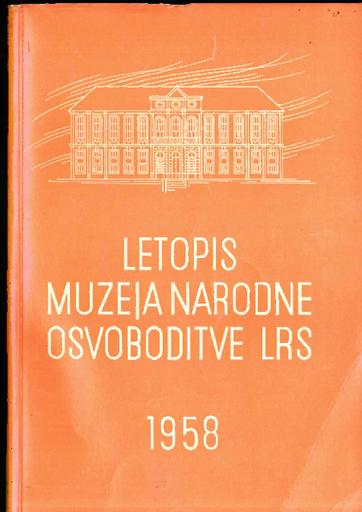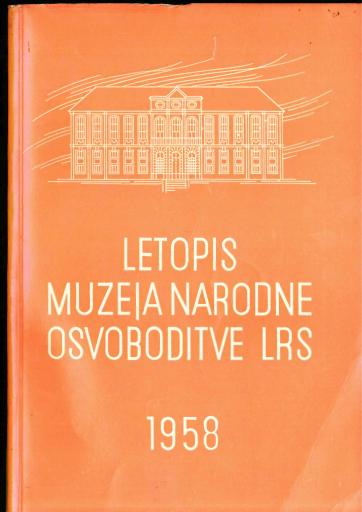/
Serijske publikacije
/
Prispevki za novejšo zgodovino
Lovro Kuhar - Prežihov Voranc v italijanskih zaporih l. 1943
(Prispevek k življenjepisu)

Datoteke (1)

Opis
V Prežihovem- zborniku je Jože Koruza objavil »Življenjsko pot Lovra Kuharja -Prežihovega Voranca« (str. 167—220) in na strani 210/1 glede na Prežihovo ilegalno delo med vojno v Ljubljani in o njegovi aretaciji 8. januarja 1943 zapisal: »Zanimivo je, kako je zmogel Lovro Kuhar, ki je opravljal vse neštevilne politične posle in bil med organizatorji osvobodilnega gibanja, stalno zasledovan od okupatorjev, prikrivati svoje delovanje sredi Ljubljane, kjer ga je poznalo velikansko število ljudi, ne da bi se bil pri tem preveč skrival. Ko je zbiral ljudsko posojilo za Osvobodilno fronto, se ni ustrašil stopiti niti k političnim nasprotnikom. Zaupal je svojemu čutu, ki ga je opozoril na sleherno nevarnost. Tudi iz zagate se je vedel dobro zmazati, če je zašel na območje kake racije. Znane so številne anekdote, kako se je znal spretno izmuzniti mimo sovražnih stražarjev. Dvakrat so ga ob raciji celo priprli, ne da bi vedeli, kdo je, ker je imel listine na drugo ime. Tudi sumljiv ni bil videti, ker se je med okupacijo, da bi laže hodil bolj nemoteno, bolje oblačil in nosil tudi naočnike.« Če upoštevamo vse to, se nam zdi toliko bolj čudno, kako da so ga mogli dne 8. januarja 1943 dobiti belogardisti v pest.
Metapodatki (11)
- identifikatorhttps://hdl.handle.net/11686/4588
- naslov
- Lovro Kuhar - Prežihov Voranc v italijanskih zaporih l. 1943
- (Prispevek k življenjepisu)
- Lovro Kuhar ("Prežihov Voranc") in Italian Jails, 1943
- ustvarjalec
- Janko Jarc
- soavtor
- Milan Bevc (odg. ur.)
- predmet
- Prežihov Voranc
- druga svetovna vojna
- 1943
- italijanski zapori
- Prežihov Voranc
- Second World War
- 1943
- opis
- As early as in his first literary attempts Lovro Kuhar, by his pen-name Prežihov Voranc, tended to deal with proletarian motives from farmers-' and workmen's life. During the First World War 1914—1918 he became as a prisoner acquainted with the scientific -bases of Marxism, and. after his return immediately joined the newly founded Communist Party of Yugoslavia, At Guštanj, where he was an employee he organized the first cells of- the Communist Party among the workmen of the Steel-Works, and founded assistance, economical and cultural organizations for them. After the dissolution of the Communist Party in the year 1920 he continued working illegally. When King Alexander's dictatorial regime came into power, Kuhar avoided arrest and judicial procedure by escaping abroad, where he developed an extensive propagating and organizing activity in various European countries in the decade 1930—1940. At the beginning of the 2nd World War (1939) he returned secretly to Yugoslavia and lived illegally in Dolenjska (the Lowland of Slovenia), in Zagreb, where he was taken by the enemy occupation of Yugoslavia, and at Ljubljana. When the Liberation Front of the Slovene People was established, he joined it immediately, and set to work particularly among, the Slovene intellectuals. He was then living at Ljubljana, Gajeva (during the occupation: Verdijeva, today: Kidričeva) 7, under the illegal name Peter Gižnar. As early as in prewar Yugoslavia the domestic clerical and fascist collaborationists had been continually charging Kuhar as a dangerous communist agitator; this had become manifest at the occasion of Kuhar winning literary prizes in 1940. During the struggle for liberation against the occupants the same circles denounced him again as a leading personality of the rebel movement, imputing to him an even more important function than he really had. This is why the Italian police took every effort to track him down; but they succeeded, quite accidentally, only January 8th, 1943. on that day Kuhar happened to have an appointment with a functionary of the Liberation Front, Stane Štrekelj, in the flat of a land-surveyor, M. Cemivec, on the then Bleiweisova (former Tyrseva] today Titova) cesta. Štrekelj had already been Shadowed by the Italian police for some time; on that day he was being followed by a patrol composed of some informers of the Italian »Questura« and agents of the White Guard's Special Department. Following Štrekelj, they burst into M. Černivec's flat and arrested them both. After that, Danica Križ arrived there, a courier of the Liberation Front, canning some material for illegal printing and secret correspondence. The agents searched her, arrested her too, and took them all to the custody of the Anticommunist Militia in the barracks on Tabor Square. There, Kuhar's nephew, the white-guardsman Ljubo Konečnik, recognized his uncle hidden under the name Peter Čižnar. Thus unmasked, Lovro Kuhar was (already on the following day) taken by the Questura to their custody, where they began interrogating him January 24th. Kuhar's arrest had been given the greatest publicity, particularly by the two clerical dailies »Slovenec« and »Slovenski dom«; so, the German Security Police as well took an interest in Kuhar. Their agents, were questioning him in April and May, 1943, on the ground of their own extensive information provided by the German police in Vienna, Prague and Paris. So, Kuhar was transferred to the custody of the Italian Military Tribunal only in late May, 1943. There he was interrogated by the Military Prosecutor in June, and not before August was the trial fixed against Kuhar and his co-defendants. Previously, the Military Tribunal had also questioned the chief editor of the daily »Slovenec«, Rudo Jurčec, who had repeated all the charges earlier published by the clerical newspapers. Hence, the Military Prosecutor had not given credence to Kuhar's vindications in the preliminary procedure (where Kuhar had been continually stressing his attachment to Marxism and communism, denying at the same time any leading function of his), but charged him with a leading part in the Communist Party of Slovenia and the Front of Liberation, with comphcity in rebellion, with revolutionary propaganda and use of a forged identity card. Meanwhile the members of the Arts Class of the Slovene Academy of Science and Art — the poet Oton Župančič, the writer F. S. Finžgar, the architect Jože Plečnik, the composer Anton Lajovic, and the academic painter Matija Jama, as the most eminent representatives of Slovene creative arts — had appealed by a petition to the commander of the Italian occupying army in Slovenia, general Gastone Gambara, for an intervention in the procedure of the Military Tribunal for Kuhar's, as an outstanding Slovene writer's, behoof. But at that time Italy had already met with her complete military and political collapse: the trial fixed by the Military Tribunal for August 26th, 1943, had been deferred to September 16th and September 8th Italy's capitulation occurred. Two days after, German troops seized Ljubljana; within a few more days Kuhar was deported to the German concentration camp Sachsenhausen, and thence, in February 1945, to Camp Mauthausen, where he was (as a sick and physically broken man) released in May 1945. He died in the year 1950.
- V Prežihovem- zborniku je Jože Koruza objavil »Življenjsko pot Lovra Kuharja -Prežihovega Voranca« (str. 167—220) in na strani 210/1 glede na Prežihovo ilegalno delo med vojno v Ljubljani in o njegovi aretaciji 8. januarja 1943 zapisal: »Zanimivo je, kako je zmogel Lovro Kuhar, ki je opravljal vse neštevilne politične posle in bil med organizatorji osvobodilnega gibanja, stalno zasledovan od okupatorjev, prikrivati svoje delovanje sredi Ljubljane, kjer ga je poznalo velikansko število ljudi, ne da bi se bil pri tem preveč skrival. Ko je zbiral ljudsko posojilo za Osvobodilno fronto, se ni ustrašil stopiti niti k političnim nasprotnikom. Zaupal je svojemu čutu, ki ga je opozoril na sleherno nevarnost. Tudi iz zagate se je vedel dobro zmazati, če je zašel na območje kake racije. Znane so številne anekdote, kako se je znal spretno izmuzniti mimo sovražnih stražarjev. Dvakrat so ga ob raciji celo priprli, ne da bi vedeli, kdo je, ker je imel listine na drugo ime. Tudi sumljiv ni bil videti, ker se je med okupacijo, da bi laže hodil bolj nemoteno, bolje oblačil in nosil tudi naočnike.« Če upoštevamo vse to, se nam zdi toliko bolj čudno, kako da so ga mogli dne 8. januarja 1943 dobiti belogardisti v pest.
- založnik
- Muzej narodne osvoboditve LRS
- datum
- 1958
- tip
- besedilo
- jezik
- Slovenščina
- jeDelOd
